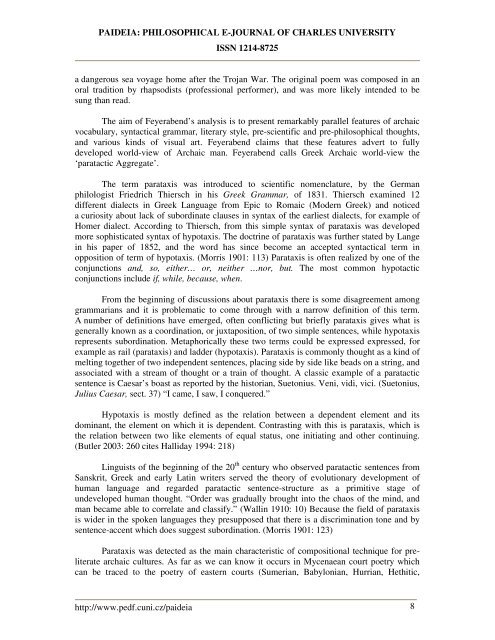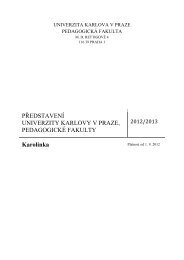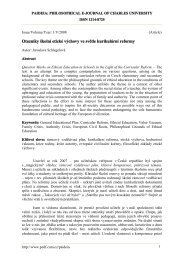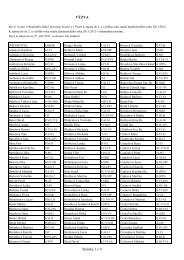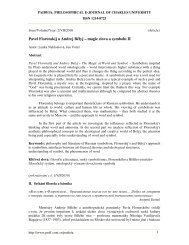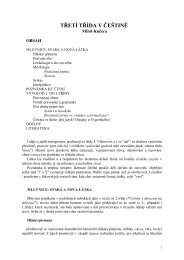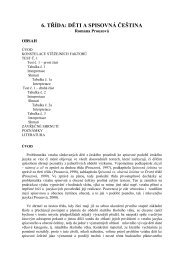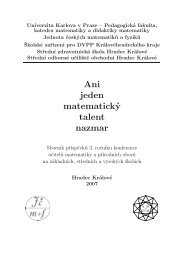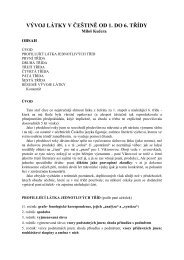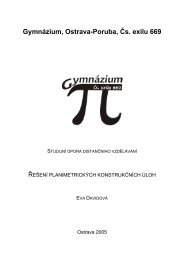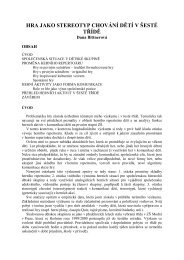Feyerabend's interpretation of Archaic Age
Feyerabend's interpretation of Archaic Age
Feyerabend's interpretation of Archaic Age
You also want an ePaper? Increase the reach of your titles
YUMPU automatically turns print PDFs into web optimized ePapers that Google loves.
PAIDEIA: PHILOSOPHICAL E-JOURNAL OF CHARLES UNIVERSITYISSN 1214-8725a dangerous sea voyage home after the Trojan War. The original poem was composed in anoral tradition by rhapsodists (pr<strong>of</strong>essional performer), and was more likely intended to besung than read.The aim <strong>of</strong> Feyerabend’s analysis is to present remarkably parallel features <strong>of</strong> archaicvocabulary, syntactical grammar, literary style, pre-scientific and pre-philosophical thoughts,and various kinds <strong>of</strong> visual art. Feyerabend claims that these features advert to fullydeveloped world-view <strong>of</strong> <strong>Archaic</strong> man. Feyerabend calls Greek <strong>Archaic</strong> world-view the‘paratactic Aggregate’.The term parataxis was introduced to scientific nomenclature, by the Germanphilologist Friedrich Thiersch in his Greek Grammar, <strong>of</strong> 1831. Thiersch examined 12different dialects in Greek Language from Epic to Romaic (Modern Greek) and noticeda curiosity about lack <strong>of</strong> subordinate clauses in syntax <strong>of</strong> the earliest dialects, for example <strong>of</strong>Homer dialect. According to Thiersch, from this simple syntax <strong>of</strong> parataxis was developedmore sophisticated syntax <strong>of</strong> hypotaxis. The doctrine <strong>of</strong> parataxis was further stated by Langein his paper <strong>of</strong> 1852, and the word has since become an accepted syntactical term inopposition <strong>of</strong> term <strong>of</strong> hypotaxis. (Morris 1901: 113) Parataxis is <strong>of</strong>ten realized by one <strong>of</strong> theconjunctions and, so, either… or, neither …nor, but. The most common hypotacticconjunctions include if, while, because, when.From the beginning <strong>of</strong> discussions about parataxis there is some disagreement amonggrammarians and it is problematic to come through with a narrow definition <strong>of</strong> this term.A number <strong>of</strong> definitions have emerged, <strong>of</strong>ten conflicting but briefly parataxis gives what isgenerally known as a coordination, or juxtaposition, <strong>of</strong> two simple sentences, while hypotaxisrepresents subordination. Metaphorically these two terms could be expressed expressed, forexample as rail (parataxis) and ladder (hypotaxis). Parataxis is commonly thought as a kind <strong>of</strong>melting together <strong>of</strong> two independent sentences, placing side by side like beads on a string, andassociated with a stream <strong>of</strong> thought or a train <strong>of</strong> thought. A classic example <strong>of</strong> a paratacticsentence is Caesar’s boast as reported by the historian, Suetonius. Veni, vidi, vici. (Suetonius,Julius Caesar, sect. 37) “I came, I saw, I conquered.”Hypotaxis is mostly defined as the relation between a dependent element and itsdominant, the element on which it is dependent. Contrasting with this is parataxis, which isthe relation between two like elements <strong>of</strong> equal status, one initiating and other continuing.(Butler 2003: 260 cites Halliday 1994: 218)Linguists <strong>of</strong> the beginning <strong>of</strong> the 20 th century who observed paratactic sentences fromSanskrit, Greek and early Latin writers served the theory <strong>of</strong> evolutionary development <strong>of</strong>human language and regarded paratactic sentence-structure as a primitive stage <strong>of</strong>undeveloped human thought. “Order was gradually brought into the chaos <strong>of</strong> the mind, andman became able to correlate and classify.” (Wallin 1910: 10) Because the field <strong>of</strong> parataxisis wider in the spoken languages they presupposed that there is a discrimination tone and bysentence-accent which does suggest subordination. (Morris 1901: 123)Parataxis was detected as the main characteristic <strong>of</strong> compositional technique for preliteratearchaic cultures. As far as we can know it occurs in Mycenaean court poetry whichcan be traced to the poetry <strong>of</strong> eastern courts (Sumerian, Babylonian, Hurrian, Hethitic,http://www.pedf.cuni.cz/paideia 8


